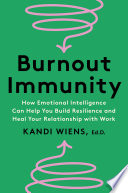

Burnout is a state of emotional, physical, and mental exhaustion caused by prolonged and excessive stress. It can lead to feelings of helplessness, cynicism, and a lack of accomplishment. The book emphasizes the importance of recognizing the signs of burnout early on to prevent it from escalating. Understanding the psychology behind burnout is crucial; it is not just about workload but also about how individuals perceive their work and their ability to cope with stressors. The author discusses various factors that contribute to burnout, including workplace culture, personal expectations, and the impact of technology on work-life balance. By understanding these dynamics, individuals can take proactive steps to mitigate burnout risks.
Continue readingThe book highlights the significance of mindset in combating burnout. A growth mindset, characterized by resilience and adaptability, can serve as a buffer against the stresses that lead to burnout. The author argues that cultivating a positive mindset allows individuals to reframe challenges and setbacks as opportunities for learning and growth. Techniques such as mindfulness, gratitude practices, and cognitive restructuring are discussed as methods to foster a healthier mindset. By changing how we think about stress and failure, we can reduce the likelihood of burnout and enhance our overall well-being.
Continue readingBurnout is often exacerbated by poor work-life balance, which is why the book advocates for work-life integration rather than strict separation. The author explains that integrating personal and professional life can lead to greater satisfaction and reduced stress. This involves setting boundaries, prioritizing self-care, and being intentional about how time is spent both at work and home. The book provides practical strategies for achieving this balance, such as flexible work arrangements and the importance of taking breaks and vacations. By rethinking how we approach work and personal life, individuals can create a more sustainable lifestyle that minimizes burnout.
Continue readingOne of the key strategies for preventing burnout is the establishment of robust support systems. The book emphasizes the importance of social connections, both at work and in personal life. Support from colleagues, friends, and family can provide emotional resilience and practical assistance during challenging times. The author discusses how to cultivate these relationships, including effective communication and fostering a sense of community within the workplace. By surrounding ourselves with supportive individuals, we can better navigate the stresses of life and work, reducing the risk of burnout.
Continue readingSelf-care is presented as a vital component in the fight against burnout. The book outlines various self-care practices that can enhance resilience, such as regular exercise, healthy eating, adequate sleep, and relaxation techniques. The author argues that self-care is not selfish but essential for maintaining overall health and productivity. Additionally, the book introduces resilience-building exercises that help individuals develop coping strategies for stress. By prioritizing self-care and resilience, individuals can create a buffer against the pressures that lead to burnout.
Continue readingBurnout often stems from a disconnect between personal values and professional goals. The book encourages readers to take the time to reevaluate what truly matters to them and align their work with their core values. This process involves introspection and may require making difficult choices about career paths or job responsibilities. The author provides guidance on how to identify personal values and integrate them into daily work life. By ensuring that one’s work is meaningful and aligned with personal values, individuals can find greater fulfillment and reduce the risk of burnout.
Continue readingWhile individual strategies are essential, the book also addresses the role of organizations in preventing burnout. The author argues that workplaces must foster a culture that prioritizes employee well-being. This includes creating policies that support mental health, encouraging open communication, and recognizing employee contributions. The book discusses how organizational leaders can implement changes that promote a healthier work environment, ultimately benefiting both employees and the organization as a whole. By taking collective responsibility for burnout prevention, organizations can create sustainable work practices that enhance employee satisfaction and productivity.
Continue reading